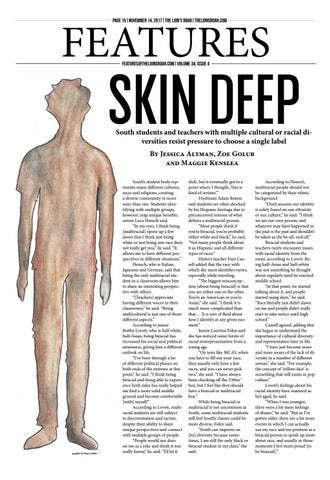FEATURES page 15|november 14, 2017|THE LION’S ROAR|THELIONSROAR.COM
FEATURES@thelionsroar.com|VOLUME 34, ISSUE 4
SKIN DEEP
South students and teachers with multiple cultural or racial diversities resist pressure to choose a single label By Jessica Altman, Zoe Golub and Maggie Kenslea
graphic by Maya Zeldin
South’s student body represents many different cultures, races and religions, creating a diverse community in more ways than one. Students identifying with multiple groups, however, reap unique benefits, senior Luca Hensch said. “In my eyes, I think being [multiracial] opens up a few doors that I think just being white or just being one race does not really get you,” he said. “It allows me to have different perspectives in different situations.” Hensch, who is Italian, Japanese and German, said that being the only multiracial student in a classroom allows him to share an interesting perspective with others. “[Teachers] appreciate having different voices in their classrooms,” he said. “Being multicultural is just one of those different aspects.” According to junior Bobby Lovett, who is half-white, half-Asian, being biracial has increased his social and political awareness, giving him a different outlook on life. “I’ve been through a lot of different political phases on both ends of the extreme at this point,” he said. “I think being biracial and being able to experience both sides has really helped me find a more solid middle ground and become comfortable [with] myself.” According to Lovett, multiracial students are still subject to discrimination and racism, despite their ability to share unique perspectives and connect with multiple groups of people. “People would use slurs on me as a joke and think it was really funny,” he said. “I’d let it
slide, but it eventually got to a point where I thought, ‘this is kind of serious.’” Freshman Adam Rotem said students are often shocked by his Hispanic heritage due to preconceived notions of what defines a multiracial person. “Most people think if you’re biracial, you’re probably either white and black,” he said. “Not many people think about it as Hispanic and all different types of races.” History teacher Faye Cassell added that the race with which she most identifies varies, especially while traveling. “The biggest misconception [about being biracial] is that you are either one or the other. You’re an American or you’re Asian,” she said. “I think it is much more complicated than that. ... It is sort of fluid about how I identify at any given moment.” Junior Laurissa Foley said she has noticed some forms of racial misrepresentation from a young age. “On tests like MCAS, when you have to fill out your race, they usually only have a few races, and you can never pick two,” she said. “I have always been checking off the ‘Other’ box, but I feel like they should have a biracial or multiracial box.” While being biracial or multiracial is not uncommon at South, some multiracial students still feel South’s classes could be more diverse, Foley said. “South can improve on [its] diversity because sometimes, I am still the only black or biracial student in my class,” she said.
According to Hensch, multiracial people should not be categorized by their ethnic background. “Don’t assume our identity is solely based on our ethnicity or our culture,” he said. “I think we are our own person, and whatever may have happened in the past is the past and shouldn’t be taken as the be-all, end-all.” Biracial students and teachers rarely encounter issues with racial identity from the onset, according to Lovett. Being half-Asian and half-white was not something he thought about regularly until he reached middle school. “At that point, we started talking about it, and people started using slurs,” he said. “Race literally just didn’t dawn on me and people didn’t really start to take notice until high school.” Cassell agreed, adding that she began to understand the importance of cultural diversity and representation later in life. “I have just become more and more aware of the lack of diversity in a number of different arenas,” she said. “For example, the concept of ‘yellow-face’ is something that still exists in pop culture.” Lovett’s feelings about his racial identity have matured as he’s aged, he said. “When I was younger, there were a lot more feelings of shame,” he said. “But as I’ve gotten older, there are a lot more events in which I can actually use my race and my position as a biracial person to speak up more about race, and usually in those moments I feel more proud [to be biracial].”
